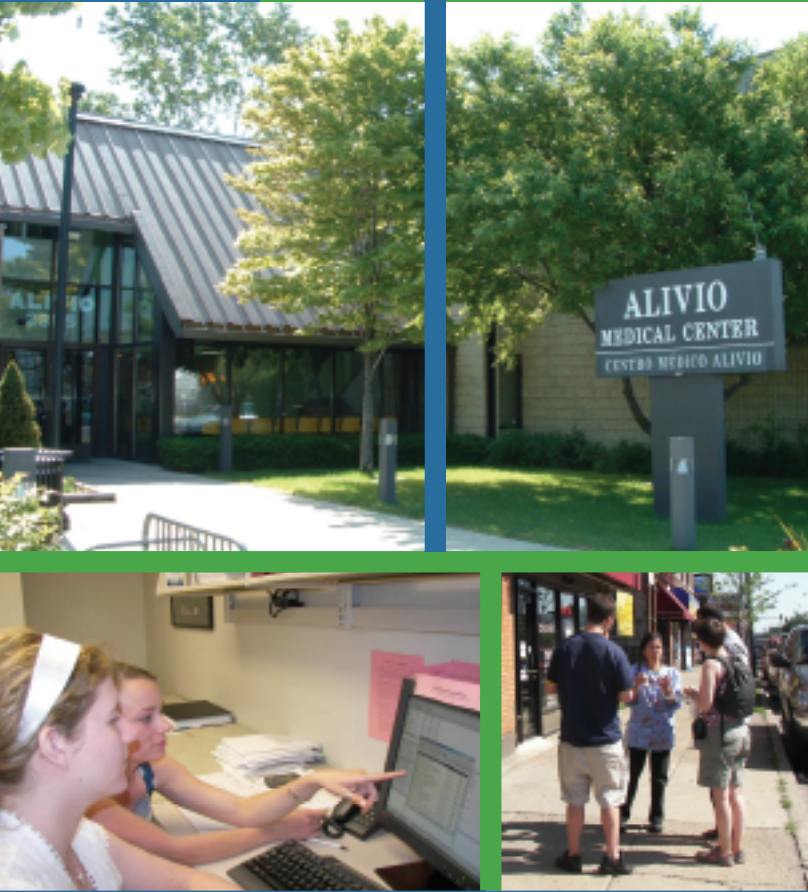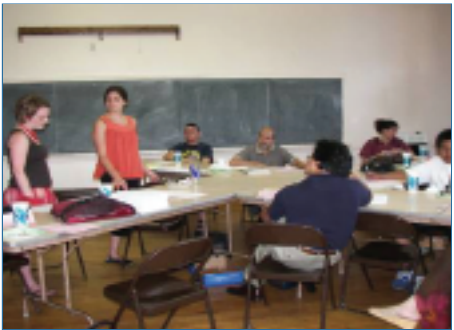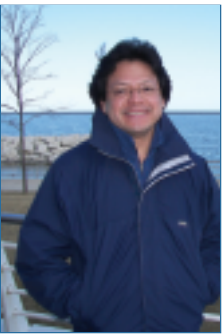
For the last two years, Hernández-Arias has been a co-principal investigator
of the Community Health Assets and Needs Assessment (CHANA), a
community-based participatory research project designed to assess health
resources and needs among the residents of four communities on Chicago’s
South Side—Armour Square, Archer Heights, Bridgeport and Gage Park.
Armour Square is a predominantly Chinese-American community; Archer
Heights and Gage Park all have significant Latino immigrant populations, and
Bridgeport is a heterogeneous neighborhood. The project focuses on health
issues facing low-income immigrant communities of color. What HernándezArias and his colleagues have documented are diverse neighborhoods, a variety
of health-related concerns and communities that have a wide range of
resources and assets.
The CHANA project emphasizes the wide—and often-neglected—range
of community assets in low-income neighborhoods, from a health clinic used
by residents and a fresh produce market to a program for youth at a local park
district facility. In almost all cases, however, when the outside world tries to
understand the health status of immigrants living in such neighborhoods,
assets are rarely considered. Identifying assets is important to begin
addressing health needs with the resources that are immediately available.
Hernández-Arias' main research interest is on immigration and health;
he was struck by the lack of available information on this subject.

“Some
government sources claim that 20 percent of the workforce is composed
of immigrants – and yet there is no data that documents the health conditions
of immigrants,” he states, “How is that possible?”
The lack of community-based data specifically about immigrants makes
the CHANA project useful to community-based organizations that are eager
to use the information. Esther Wong, Executive Director of the Chinese
American Service League, a partner in CHANA, added that “as a Chinese
social service agency, we are always interested in research, because there’s not
that much research on our communities. The survey conducted by this project
was more environmental, social and community-oriented in nature than what
we usually see.
Community-based Research Model
The CHANA project is distinguished by how it
involves the community; the project’s communitybased participatory research approach was to ask
immigrants how they take care of health concerns.
Data collection for four segments of the project
was completed by community residents.
Throughout the project, DePaul students analyzed
data collected by more than 200 community
residents; the projects involved collecting data
through 32 individual interviews, 24 focus groups,
1,190 residential surveys, and 685 block inventories.
The research also features a protocol that kept the
cost low, a method that will benefit organizations
that may want to replicate the project. “If you are
an immigrant, you are paying a toll in so many
areas,” Hernández-Arias said, “The beauty of
community-based participatory research is that it
gives people an outlet through which they can
articulate what they know.”

The research shows how health-related issues
can look very di4erent between two neighborhoods,
even if they are located adjacent to one another, or
even within a neighborhood. For instance, in
analyzing the block inventories, students realized
that the north part of Armour Square contains a
variety of stores with fresh produce, while in a lowincome neighborhood in the south part of the
neighborhood it was very di3cult to find any fresh
produce at all. The project also found that Armour
Square has sixteen social service organizations,
while Archer Heights has only two.
There are many ways that community
organizations can use the data collected in the four
components of the CHANA project. For example,
the research revealed that thousands of eligible
families reported not knowing about the State of
Illinois’ All Kids program—a program that
guarantees insurance for all children in the state.
That kind of information can be shared with
community residents to inform them about
available means of having access to medical service
resources, at least for children and adolescents.
Partners
The CHANA Project brought together a range of
key research partners who formed the project’s
Community Advisory Council, which includes
representatives from Alivio Medical Center, the
Chicago Department of Public Health and four
community-based organizations—the Chinese
American Service League, Latino Organization of
the Southeast, the Inner-City Muslim Action
Network, and San Miguel Schools, and DePaul
University. The primary financial sponsor of the
project is Alivio Medical Center, a bilingual,
bicultural nonprofit health center that serves more
than 20,000 people a year and draws patients from
all four surveyed communities.
Carmen Velasquez, Founder and Executive
Director of Alivio Medical Center, was a coprincipal investigator for the project with
Hernández-Arias. “We wanted to document what
people are feeling about health care and what
problems they have in accessing the system,”
said Velasquez. “The uniqueness here is in the tools
developed by the project. They are going
to be available to any community entity.”
Velasquez praises Hernández-Arias for
“recognizing the opportunity to work with our
health center, and allowing for his students to be
actively engaged in the process.” She said the
CHANA project has “a bottoms-up approach.
It has soul and reflects the real feelings of
the people.”
Data provided by participants in the project
create a broader vision of public health in their
neighborhoods. “This research provides the kind of
information that is invaluable to the health
department,” says Joseph Harrington, Assistant
Commissioner of the Chicago Department of
Public Health, which endorsed the project. “We
have significant information about birth and death.
The question is: What happens in between? This
project can provide research-based, analytical data
about the health of communities and individuals.
That can help us make plans and projections.”
Harrington added that the CHANA project can
greatly benefit communities. “Communities have
the power to frame public policy,” he claimed,
“To the extent that community members have
information about real concerns from this project,
they can articulate those concerns to elected
o3cials.”
DePaul Student
Involvement
Essential
Over the years,
Hernández-Arias
designed four distinct
courses related to the
project of which he
taught a total of nine
sections. The classes
are research design and research methods as well as
on quantitative and qualitative health data analysis.
Thus far, 118 DePaul students have participated in
the project as researchers providing a service to
communities.

Britt Skaathun, who earned her degree in
Sociology at DePaul, was a student research
assistant on health-related issues in the community.
Her work on a community assessment helped set
the stage for the CHANA project. “This work gives
you a di4erent perspective as a student,” she noted.
“When you realize that what you are doing can be
used by community members, it’s more inspiring.
Engagement with the community motivates you to
do a good job. You want to make sure the data is
as specific as possible.” The work with Professor
Hernández-Arias, she adds, “helped me focus my
interest for school.” Skaathun is currently pursuing
a Masters degree in epidemiology at the University
of Illinois at Chicago’s School of Public Health.Meanwhile, Mike Bielaczyc, a senior sociology major
with a health and health services concentration, took
a course on quantitative data analysis taught by
Hernández-Arias. After completing the class, he
served as a volunteer for the project. Bielaczyc, who
grew up in an immigrant community, said “our
culture owes so much to these communities, but
pays so little attention to them. Through this project,
we have the opportunity to go deeper into what
we’ve learned about these communities—and see
why certain groups describe their health status in
such different ways.
We know that health is a4ected by many physical factors, but we saw with
the CHANA project that what is around you can have an equally or more
important e4ect.” He
noted, for example,
how there are major
di4erences between the
number of health clinics
and doctors’ o3ces
in one community
compared to another.
DePaul student Jay Borchert feels there is something significant at stake with
this project. “We are learning through our research that this kind of information
can a4ect people’s lives,” informed Borchert, who is pursuing a sociology
degree at DePaul, “For me, this experience provides the opportunity to apply
social thinking to a real problem that is occurring now. It has definitely a4ected
my future goals, and helped me to focus. Now I have some real experience
interacting with communities.”
DePaul student Theresa Lasenby, who is pursuing a master’s degree in
social work, had a chance to observe and collect data on the South Armour
Square neighborhood — and witness firsthand the dearth of medical o3ces
and fresh healthy food options in the community. “I hope that elected
o3cials and others in the community can see the overall picture of what’s
happening here – even down to the details of how meat looks in a case and
what snacks are available to people,” she said. “You can’t get any more raw or
real than the data collected for this project.”